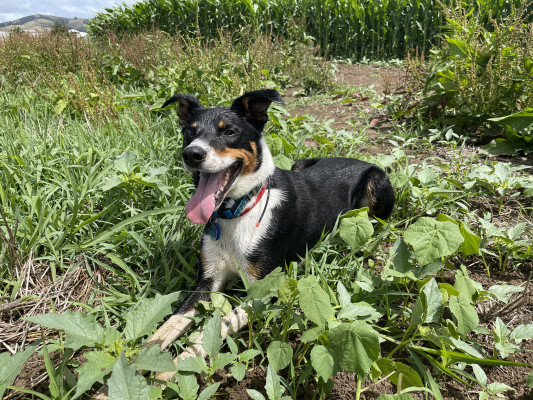A quick whiff and sniff, and Wink the dog is off. Moments later he barks and sits, to alert his handler that he's found what he's been searching for.
Wink has been trained to find a serious cropping weed called velvetleaf.
Velvetleaf has yellow buttery flowers, distinctive seed pods with heart shaped leaves that are velvety to the touch and can grow up to 2.5m tall.
A member of the mallow family, velvetleaf is notoriously hard to control and each plant can produce over 17,000 seeds which can survive for decades. If allowed to germinate, it could cause up to 70% reductions in crops.
It's a nuisance for farmers around Aotearoa, and the Ministry for Primary Industries (MPI) is asking everyone to keep an eye out for the weed.
Wink has been on the job in the South Island for the past few weeks, with his handler and trainer John Taylor.
"Velvetleaf has been found on farms around Aotearoa, it's an invasive pest that competes for space, nutrients and water, which affects crop growth," John says.
"Wink has a very keen and astute nose, much more adept than a human eye and he can locate it really quickly. It's been a team effort between Wink and myself."
When Wink locates velvetleaf, it's removed and destroyed. But everyone can help control this weed and stop its spread, John says.
"We're asking you to stay vigilant and look out for velvetleaf, we need everyone's help to control it."
If you see velvetleaf, take a photo of it and call our pest and disease line (0800 80 99 66).
Background information
- Velvetleaf seedlings are vigorous, and the plants grow very fast.
- If you see velvetleaf take a photo, mark its location and call our pest line 0800 80 99 66.
- The South Island velvetleaf Community Outreach team work with farmers on Farm Management Plans to contain the weed.
- The seed survives in maize silage and in the gut of cattle, so it has the potential to spread rapidly through farms.
- Farm, crop, and machinery hygiene are important strategies for the prevention and control of this pest.
- Velvetleaf was initially found in a fodderbeet seed incursion in the South and in maize in the North.








